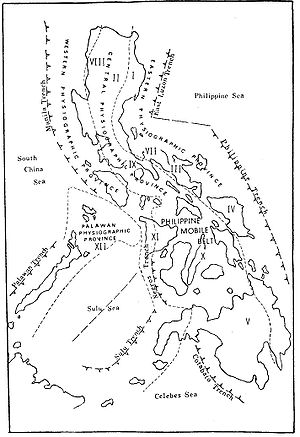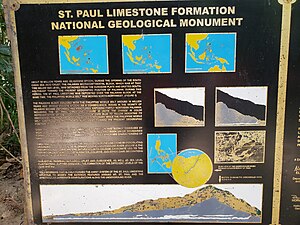This article may be in need of reorganization to comply with Wikipedia's layout guidelines. (October 2020) |


In the geology of the Philippines, the Philippine Mobile Belt is a complex portion of the tectonic boundary between the Eurasian plate and the Philippine Sea plate, comprising most of the country of the Philippines. It includes two subduction zones, the Manila Trench to the west and the Philippine Trench to the east, as well as the Philippine fault system. Within the Belt, a number of crustal blocks or microplates which have been shorn off the adjoining major plates are undergoing massive deformation.[1]
Most segments of the Philippines, including northern Luzon, are part of the Philippine Mobile Belt, which is bounded by the Philippine Sea plate to the east, the Molucca Sea Collision Zone to the south, Sunda plate to the southwest, and the South China Sea Basin to the west and north-west.[2] To the north it ends in eastern Taiwan, the zone of active collision between the North Luzon Trough portion of the Luzon Volcanic Arc and South China.[3] The Philippine Mobile Belt has also been called the Philippine Microplate[4] and the Taiwan–Luzon–Mindoro Belt.[5]
- ^ Galgana, G.A.; Hamburger, M.W.; McCaffrey, R.; Bacolcol, T.C.; Aurelio, M.A. (December 1, 2007). "Modeling the Philippine Mobile Belt: Tectonic blocks in a deforming plate boundary zone". AGU Fall Meeting Abstracts. 2007: G21C–0670. Bibcode:2007AGUFM.G21C0670G.
- ^ Rangin and Pubellier (1990) in Tectonics of Circum-Pacific Continental Margins ISBN 90-6764-132-4 p140 ff
- ^ Clift, Schouten and Draut (2003) in Intra-Oceanic Subduction Systems: Tectonic and Magmatic Processes, ISBN 1-86239-147-5 p84-86
- ^ Hashimoto, M, ed., (1981) Accretion Tectonics in the Circum-Pacific Regions, ISBN 90-277-1561-0 p302
- ^ Nicolas Pinet and Jean Francois Stephan (1989) in Tectonics of Circum-Pacific Continental Margins ISBN 90-6764-132-4 p165